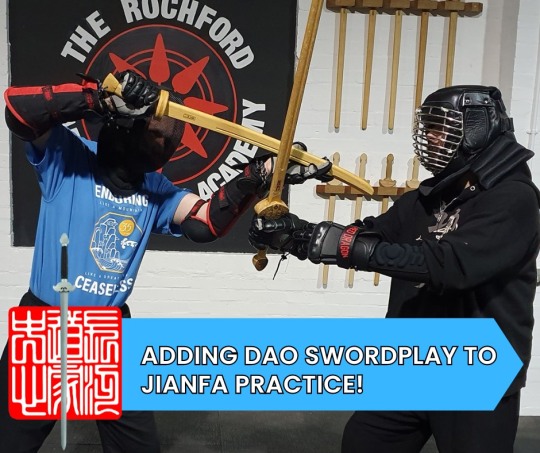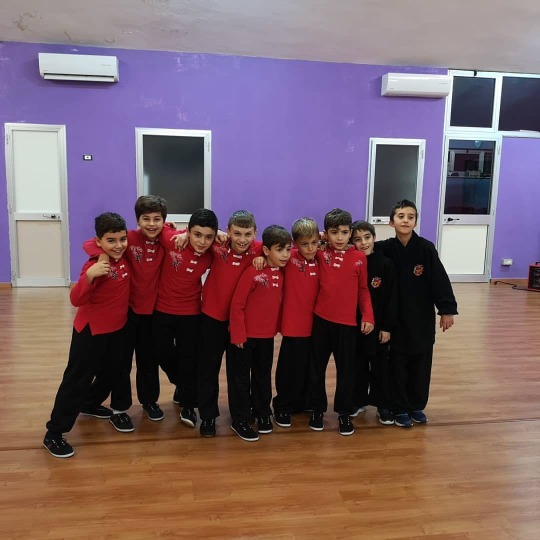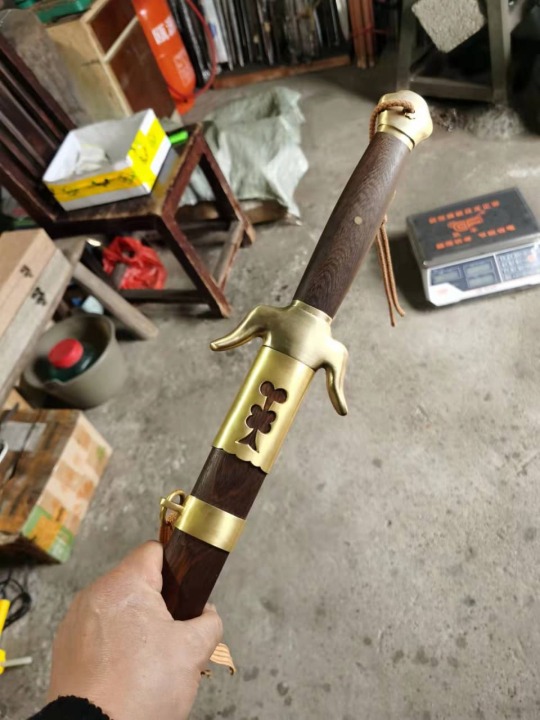#wudangsword
Text

Merging Jianfa & Daofa in Your Swordplay:
Practitioners of Jianfa looking to explore the depths of Chinese swordsmanship, incorporating Daofa, the art of the saber, can add a more assertive, power orientated flavor to your swordplay.
This journey is not just a weapons switch up; it's about expanding your mindset, augmenting your skill set, while broadening your approach to swordsmanship.
In this guide, we'll navigate through the transition, focusing on practical techniques and insights to enhance your martial arts skills.
The Jian, with its straight, double-edged blade, epitomizes precision, agility, and adaptability, demanding a level of finesse and fine movement.
In contrast, the Dao, featuring heavier cuts, is a single-edged blade, representing power and efficiency in combat.
Uniting Daofa with Jianfa involves more than learning to handle a different sword, it means embracing a different approach in swordplay.
The Dao's point of balance is more forward than the Jian’s. This provides for more powerful cuts and thus a significant shift in technique. Daofa focuses not on the quick, wrist-led maneuvers that are the essence of Jianfa, instead focusing on powerful, elbow-driven techniques.
This style engages larger muscle groups for stronger and more impactful strikes, a key aspect in effectively wielding the Dao.
Starting with Pi Cut from Stirring Deflection
Begin your transformation with a drill common to both Jianfa and Daofa, the Pi cut from a stirring deflection. This provides a familiar base while introducing Dao's unique handling characteristics.
Chan involves a binding or wrapping movement, where the blade circles the body. It's a deflecting technique where the flat of the blade is used to deflect an incoming cut on one side of the body and then continues the motion to circle the blade around the torso, behind the back. This allows for a follow-up cut from the opposite side.
Deflecting with a Chan movement, the empty hand moves inside the blade, close to the chest, and can be employed to momentarily control the opponent’s sword arm as one advances forward. Training this technique introduces practitioners to the closer, more direct combat style found in Daofa. In contrast, Jianfa's prefers maintaining a distance that provides space to maneuver.
After gaining familiarity with the Pi and Hua cuts, it's insightful to progress to the distinctively heavier Kan cut. The Kan is and unique to saber systems, not being present in Jianfa.
Following this, the Duo cut would be the next logical cut to add. While the Duo cut is also present in Jianfa, it’s not made use of as frequently when wielding the straight sword.Training Daofa’s use of the Duo reminds us of why we are evolving our swordplay, merging the mindsets of Jianfa and Daofa, mixing more aggressive and assertive actions into our sword work.
In practice, although the timing of the Duo cut may appear similar to its Jianfa counterpart, it requires a considerably larger window of opportunity, reflecting the bolder and more direct approach of Daofa.
This exploration into the Duo cut provides practitioners with a new perspective on the rhythm shift from the more measured Jianfa to the dynamic and forceful Daofa.
The Pi cut can be likened to the power needed to trim a leaf off a tree, the Kan cut to chopping a thick branch, and the Duo cut to the robust action of felling an entire tree or splitting a log. This progression not only illustrates the escalating power inherent in Daofa techniques but also underscores the distinct tactical mindset required for this style of swordplay.
The Gua cut, though mechanically akin to the Liao cut in Jianfa, takes on a unique role in Daofa. It focuses an aggressive sweeping action to proactively capture the line, reflecting Daofa's assertive and power-oriented nature of Dao swordplay.
Incorporating shield work, especially with durable circular cost effective riot shields, provides insight into how the Dao would have been wielded on the battlefield. This practice not only enhances sword skills but also offers a better understanding of strategic defense and offense in historical combat contexts.
You can use a rattan Tengpai, but these are a lot more costly than a riot shield, which are far cheaper and will hold up to virtually anything you can throw at it during swordplay.
These individual cut drills can be combined into dynamic semi-fixed sparring routines, crucial for experiencing the reactive and adaptive nature of Daofa and preparing for unpredictable combat situations.
Merging Jianfa to Daofa offers an opportunity to evolve your understanding of Chinese swordsmanship, introducing new techniques and strategic thinking. It also adds tactical options to your swordplay, making you less predictable. This journey, embraced with dedication and an open mind, not only enhances your swordplay skills but also enriches your overall approach to swordsmanship. Enjoy the growth and mastery that come with learning the powerful art of the Daofa.
—----
All of the drills and cuts discussed in this guide can be found in the Daofa sections of the Academy of Chinese Swordsmanships Online Archives. Available to all members of the Daofa and Sword Scholars Study paths.
Visit www.chineseswordacademy.com for more details.
#chineseswordsmanship#jianfa#duanbing#chinesemartialarts#chineseswordplay#chineseswordfighting#scottmrodell#jianshu#daofa#scottrodell#daoistswordarts#chineseswordarts#swordfightingclasses#ukchineseswordfighting#taijijian#taijiswordfencing#taijisword#wudangsword#wudangjian#taijidao#taijisaber#swordfightingschool#kungfuweapons#swordfightingskills#chineseswordwork#swordtraining#劍法#刀法#chinesesword#yangjiamichuantaijijian
6 notes
·
View notes
Text
0 notes
Photo

@accademia_del_pugno_del_drago @hezizheng @annapaolaraiola Accademia del pugno del drago e I suoi bellissimi draghetti!!! #kungfu #kungfulife #kungfutorre #kungfufight #kungfubaby #kungfulifestyle #kungfutechnique #kungfupose #kungfusword #accademiadelpugnodeldrago #traininghard #wudang #wudangshan #wudangkungfu #wudangpai #taiji #chinesekickboxing #wushu #wudangjian #wudangsword #borntofight #gym #workout #workoutmotivation #artimarziali #martialartslife #martialarts #friends https://www.instagram.com/p/B6ILhBLoHXL/?igshid=1e0clt8h8tc45
#kungfu#kungfulife#kungfutorre#kungfufight#kungfubaby#kungfulifestyle#kungfutechnique#kungfupose#kungfusword#accademiadelpugnodeldrago#traininghard#wudang#wudangshan#wudangkungfu#wudangpai#taiji#chinesekickboxing#wushu#wudangjian#wudangsword#borntofight#gym#workout#workoutmotivation#artimarziali#martialartslife#martialarts#friends
1 note
·
View note
Text

Reality Check…
#jianfa#chineseswordsmanship#jianshu#chineseswordfighting#chineseswordplay#scottmrodell#swordplay#duanbing#chinesemartialarts#chinesemartialart#taijisword#wudangsword#wudangjian#daoistswordarts#yangjiamichuantaijijian#taichisword#swordfightingclasses#swordfightingschool#swordclasses#chineseswordwork#chineseswordfencing#taijiswordfencing#fullcontact#swordfighting#swordfigther#swordfights#chineseswordarts#swordarts#historicalswordsmanship#chinesesword
5 notes
·
View notes
Text
Training is a Treasure.

#jianfa#chineseswordsmanship#chineseswordfighting#scottmrodell#chinesemartialarts#duanbing#chinesemartialart#chineseswordplay#jianshu#daoistswordsman#daoistswordarts#yangjiamichuantaijijian#taijisword#taichisword#wudangsword#wudangjian#taijijian#chinesemartials#chineseswordarts#swordarts#taijiswordfencing#chineseswordfencing#ukchineseswordfighting#swordplay#swordwork#swordworkout#chineseswordwork#scottrodell#swordfightingschool#swordfightingclasses
3 notes
·
View notes
Text
FREE EBOOK COMING SOON
The Basic Cuts Of Yang Taiji Jianfa
By Scott M. Rodell
Available for free download Friday August 5.
Descriptions of all the basic cuts of Yang Taiji Jianfa including their usage in free swordplay.

Launching Friday!
#chineseswordsmanship#jianfa#chineseswordfighting#chineseswordplay#swordplay#scottmrodell#jianshu#duanbing#chinesemartialart#chinesemartialarts#scottrodell#taijijian#taijiswordfencing#taijisword#yangjiamichuantaijijian#yangshitaijijian#wudangsword#wudangjian#chineseswordwork#chinesesword#swordfightingclasses#swordfightingskills#swordclasses#chineseswordfencing#kungfuweapons#swordsmanship#daoistswordarts#daoistswordsman#chineseswordsman#chineseswordarts
2 notes
·
View notes
Text


A scroll titled Countries Figure (Kunigni Jinbutsukan) in the Kyoto National Museum depicts a Chinese Military Officer carrying a Jian. This work apparently dates to the early Ming period. What’s interesting about this image is that this military man is carrying his Jian in his left hand, rather than having it suspended from his belt. While this depiction of the sword carried in the hand rather than strapped to the belt is not new, it suggestions the idea that this depiction is not simply the standard artistic convention as the Japanese envoy who painted this was apparently recording what he saw.
Another element previously observed is that the Jian is grasped not close to the center of balance when it is sheathed, but close to the scabbard throat.
#chineseswordsmanship#jianfa#chineseswordfighting#chineseswordplay#jianshu#chinesemartialarts#duanbing#chinesemartialart#swordplay#chineseswordsman#chinesesword#taijiswordfencing#taijijian#taijisword#wudangsword#wudangjian#swordfighter#chineseswordwork#kungfuweapons#kungfu#mingdynasty#swordfightingskills
2 notes
·
View notes
Video
youtube
Scott M. Rodell presents the history and how-to of Chinese Fast Sword Drawing (出手法) and the techniques for re-scabbarding Jian. Get Started in Full Contact Swordplay, Online, and In-Person-
https://www.chineseswordacademy.com/membershipsandcourses
Use Code: cut50 for Half Off the First Two Months
#出手法#楊家秘傳太極劍#太極劍#swordclasses#swordclass#swordtraining#swordfightingskills#swordfightingschool#swordfighter#chinesemartialarts#chinesemartialart#wudangsword#wudangjian#taichisword#taijisword#taijijian#yangjiamichuantaijijian#daoistswordarts#daoistswordsman#daoistswordart#daoistsword#chineseswordarts#chineseswordart#swordart#swordarts#sword#swords#chineseswordwork#swordwork#duanbing
8 notes
·
View notes
Video
Students Training the Zha Ci Partner Drill
Leeds Chinese Swordsmanship Seminar, May 2022
Nice “skipping stone” movement where the deflection answers seamlessly with a Zha to the duifang’s sword arm, then continues in with a Ci to the sword arm shoulder as the arms is withdrawn.
One detail to note here is that some of the thrust are low and not to the shoulder as they should be. This error often occurs as the sword arms tires from a day of training. If the Ci goes too low, it should be deflected with a circular stirring deflection.
Thanks to Paul Andrew of the Xing Yi Academy for organizing our Leeds Seminars.
#楊家秘傳太極劍#太極劍#中國劍法#劍法#swordclass#swordclasses#swordtraining#swordfightingskills#swordfightingschool#swordfighter#chinesemartialart#chinesemartialarts#wudangsword#wudangjian#taichisword#taijisword#yangjiamichuantaijijian#taijijian#daoistswordarts#daoistswordsman#daoistswordman#daoistsword#chineseswordarts#chineseswordart#swordart#swordarts#swords#chineseswordwork#swordwork#duanbing
4 notes
·
View notes
Photo

The Chinese Full Contact Swordplay Tournament Dates are set, June 17 in the Washington, DC Area-
I’ll post the rules several places for those interested in competing. Note that Double Hits such as seen in this photo are not counted. When they occur, halt is called by the referee and the action centered. And then the bout continues from that point.
#太極劍#刀法#chineseswordsman#chineseswords#chinesesword#gongfu#kungfu#fullcontact#中國劍法#劍法#劍#chineselongsword#swordfighter#chinesemartialarts#chinesemartialart#swordfightingskills#swordfightingschool#wudangsword#wudangjian#taichisword#taijisword#taijijian#daoistswordarts#daoistswordsman#daoistsword#chineseswordarts#chineseswordart#swordarts#swordart#chineseswordwork
2 notes
·
View notes
Text

WANT TO LEARN CHINESE SWORDSMANSHIP?
INSTANT ACCESS. ANYWHERE. ANYTIME.
Sign up for our FREE 7 DAY TRIAL.
Find a study path that’s right for you.
#jianfa#chineseswordsmanship#chineseswordfighting#scottmrodell#chineseswordplay#chinesemartialarts#duanbing#jianshu#chineseswordarts#daoistswordart#taijiswordfencing#taijisword#taijijian#wudangsword#wudangjian#swordclasses#swordfightingschool#swordfightingskills#kungfuweapons#chineseswordfencing#historicalfencing#swordarts#swordfighting#swordfightingclasses#fullcontact#swordplay#yangjiamichuantaijijian#yangstyletaichi#yangstylestaijiquan#yangstyle
0 notes
Video
youtube
Intercepting: Jie and Ge Cuts- Chinese Swordsmanship Webinar Excerpt
Looking for a systematic method to move from Forms Only Practice to Full On Free Swordplay? It's here >>>====> https://www.chineseswordacademy.com/membershipsandcourses Online & In-Person Training. Use Code: cut50 for Half Off the First Two Months.
#chinesswordsmanship#zhongguojianfa#jianfa#jianshu#yangstyle#yangstyletaichi#taijisword#taijijian#taichisword#wudangsword#wudangjian#swordclass#swordclasses#swordfightingskills#swordfightingschool#duanbing#daoistsword#daoistswordsman#daoistswordarts#swordarts#swordart#chineseswordart#chineseswordarts#scottrodell#scottmrodell#fullcontact#swordplay#chineseswordplay#chineseswordfighting#swordfighting
12 notes
·
View notes
Photo

I put together 8 Short Sword Forms for the Academy of Chinese Swordsmanship (中華刀劍武藝學院). I drew them from the Yangjia Michuan Taiji Sword form, compacting some of the movements so they are practiced as they are applied in Free Swordplay.Sunday we worked on the 4th in the Series which starts squatting down then spring up to deliver the thrust seen here-White Ape Emerges from the Cave
For more about the Academy see: https://www.chineseswordacademy.com/
#楊家秘傳太極劍#中國劍法#劍法#太極劍#劍術#swordclass#swordtraining#swordfightingskills#swordfightingschool#swordfighter#chinesemartialart#chinesemartialarts#wudangsword#wudangjian#taichisword#taijisword#yangjiamichuantaijijian#taijijian#daoistswordarts#daoistswordsman#daoistsword#chineseswordarts#swordarts#chineseswordwork#swordwork#duanbing#chineseswordplay#swordplay#historicalswordsmanship#chineseswordfighting
12 notes
·
View notes
Photo

I have been consulting for The Art of Fire & Iron, a forge in Longquan, about swords for practitioners. We have been discussing weights, lengths, POB, that make for good cutting as well as regular form practice. One result so far is they forged a Lanling Jian prototype that is being sent to me for review and testing. If it turns out as well as expected (I was happy with their other jian I reviewed: https://www.youtube.com/watch?v=mwmcDmLaG2A), we might just see about a special offer on them for Academy of Chinese Swordsmanship Subscribers.
#zhongguojianfa#jianfa#jianshu#scottmrodell#scottrodell#chineseswordsmanship#chineseswordfighting#historicalswordsmanship#chineseswordplay#duanbing#chineseswordwork#chineseswordarts#daoistswordarts#daoistswordman#daoistsword#taijijian#taijisword#taichisword#wudangjian#wudangsword#chinesemartialarts#chinesemartialart#swordfightingschool#swordfightingskills#swordtraining#劍術#劍#中國劍法#劍法#太極劍
6 notes
·
View notes
Photo

Test Cutting is a clear reality check for your Sword Work. Simply practicing aiming a gun doesn’t make anyone an expert marksman. Drawing a bow is great strength training, but pulling the string back alone doesn’t make an archer. Solo Sword Forms are just the beginning of training in the Sword Art.
#testcutting#tameshigiri#zhongguojianfa#jianfa#中國劍法#劍法#劍#劍術#楊家秘傳太極劍#太極劍#swordclass#swordtraining#swordfightingskills#swordfightingschool#swordfighter#chinesemartialart#chinesemartialarts#wudangsword#wudangjian#taichisword#taijisword#yangjiamichuantaijijian#taijijian#daoistswordarts#daoistswordsman#daoistswordman#daoistsword#daoistswordart#chineseswordarts#daositswordarts
2 notes
·
View notes
Photo

My principle teacher, Wáng Yen-nián, 王延年.
#王延年.#中國劍法#劍法#劍#楊家秘傳太極劍#太極劍#劍術#yangjiamichuantaijijian#yangstyle#kungfu#gongfu#chinesesword#chineseswords#swordtraining#swordfightingskills#swordfightingschool#swordfighter#chinesemartialarts#chinesemartialart#wudangsword#wudangjian#taichisword#taijisword#taijijian#daoistswordarts#daoistswordsman#daoistsword#sword#swords#swordwork
2 notes
·
View notes